Generac 004992-1, 004992-0 User Manual
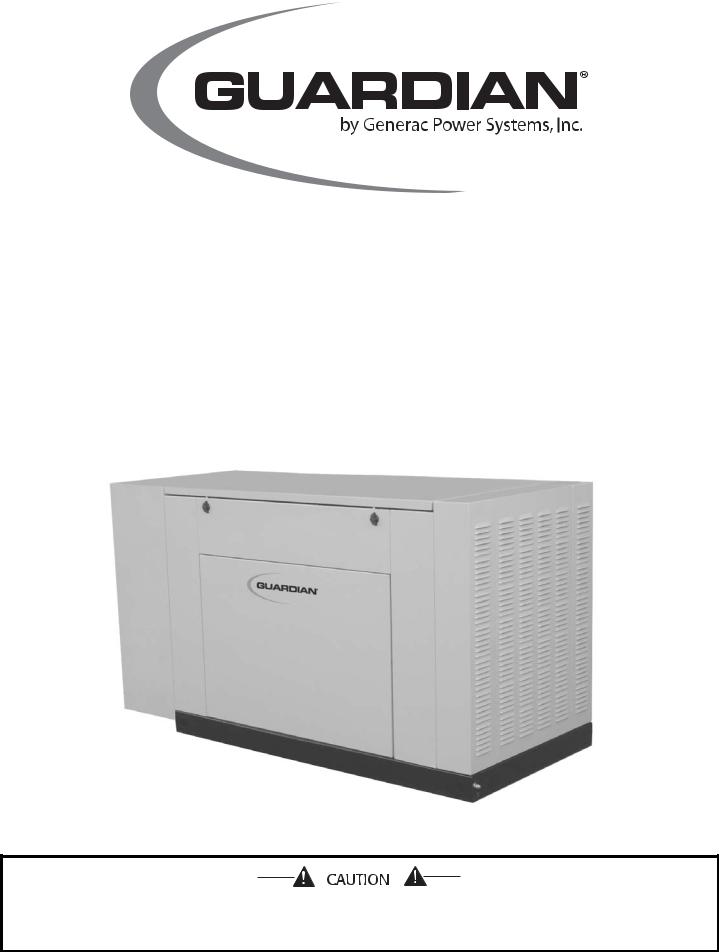
Owner’s Manual
Liquid-cooled, Prepackaged
Standby Generators
Model Nos. 004992-0
004992-1
37kW NG, 40kW LP
This manual should remain with the unit.
ONLY QUALIFIED ELECTRICIANS OR CONTRACTORS
SHOULD ATTEMPT INSTALLATION!!
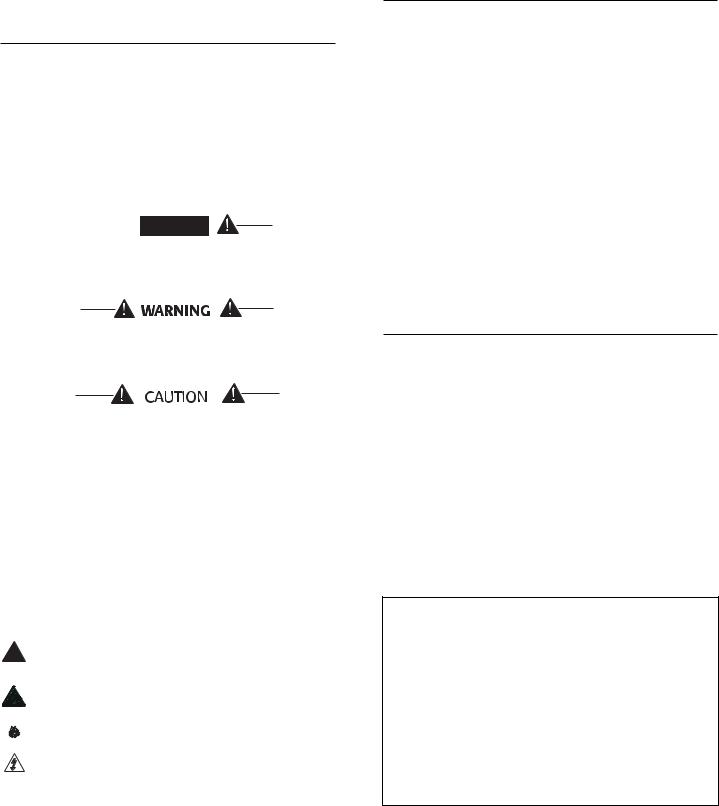
INTRODUCTION
Thank you for purchasing this model of the Guardian standby generator product line by Generac Power Systems, Inc.
Every effort was expended to make sure that the information and instructions in this manual are both accurate and current at the time the manual was written. However, the manufacturer reserves the right to change, alter or otherwise improve this product(s) at any time without prior notice.
READ THIS MANUAL THOROUGHLY
If any portion of this manual is not understood, contact the nearest authorized service dealer for starting, operating and servicing procedures.
Throughout this publication, and on tags and decals affixed to the generator, DANGER, WARNING, CAUTION and NOTE blocks are used to alert personnel to special instructions about a particular service or operation that may be hazardous if performed incorrectly or carelessly. Observe them carefully. Their definitions are as follows:

 DANGER
DANGER
After this heading, read instructions that, if not strictly complied with, will result in severe personal injury, including death, or property damage.
After this heading, read instructions that, if not strictly complied with, may result in personal injury or property damage.
After this heading, read instructions that, if not strictly complied with, could result in damage to equipment and/or property.
NOTE:
After this heading, read explanatory statements that require special emphasis.
These safety warnings cannot eliminate the hazards that they indicate. Common sense and strict compliance with the special instructions while performing the service are essential to preventing accidents.
Four commonly used safety symbols accompany the DANGER, WARNING and CAUTION blocks. The type of information each indicates is as follows:
This symbol points out important safety informa-
!tion that, if not followed, could endanger personal safety and/or property of others.
This symbol points out potential explosion hazard. |
 This symbol points out potential fire hazard.
This symbol points out potential fire hazard.
This symbol points out potential electrical shock hazard.
The operator is responsible for proper and safe use of the equipment. Generac strongly recommends that the operator read this Owner's Manual and thoroughly understand all instructions before using this equipment. Generac also strongly recommends instructing other users to properly start and operate the unit. This prepares them if they need to operate the equipment in an emergency.
OPERATION AND MAINTENANCE
It is the operator's responsibility to perform all safety checks, to make sure that all maintenance for safe operation is performed promptly, and to have the equipment checked periodically by a Generac authorized service dealer. Normal maintenance service and replacement of parts are the responsibility of the owner/operator and, as such, are not considered defects in materials or workmanship within the terms of the warranty. Individual operating habits and usage contribute to the need for maintenance service.
Proper maintenance and care of the generator ensures a minimum number of problems and keep operating expenses at a minimum. See the authorized service dealer for service aids and accessories.
Operating instructions presented in this manual assume that the standby electric system has been installed by an authorized service dealer or other competent, qualified contractor. Installation of this equipment is not a “do-it-yourself” project.
HOW TO OBTAIN SERVICE
When the generator requires servicing or repairs, contact an authorized service dealer for assistance. Service technicians are factory-trained and are capable of handling all service needs.
When contacting an authorized service dealer about parts and service, always supply the complete model number of the unit as given on the front cover of this manual or on the DATA CARD affixed to the unit.
AUTHORIZED SERVICE
DEALER LOCATION
To locate the nearest AUTHORIZED SERVICE DEALER, please call this number:
1-800-333-1322
OR
Locate us on the web at:
www.guardiangenerators.com
Generac® Power Systems, Inc.

Table of Contents
INTRODUCTION................................................ |
IFC |
|
SAFETY RULES .................................................... |
2 |
|
Section 1 — GENERAL INFORMATION ............ |
4 |
|
1.1 |
Generator .............................................................. |
4 |
1.2 |
Transfer Switch .................................................... |
4 |
1.3 |
Automatic System Operation ................................ |
4 |
1.4 |
Generator AC Connection Systems........................ |
4 |
1.5 |
Main Circuit Breaker ............................................ |
4 |
1.6 |
Generator Fuel System .......................................... |
5 |
1.7 |
Engine Protective Devices ...................................... |
5 |
1.8 |
Unpacking ............................................................ |
6 |
1.9 |
Lifting the Generator ............................................ |
6 |
1.10 |
Specifications ........................................................ |
7 |
1.11 |
Fuel Consumption ................................................ |
7 |
1.12 |
Reconfiguring the Fuel System .............................. |
7 |
1.13 |
Torque Specifications ............................................ |
8 |
1.14 |
Engine Oil Recommendations .............................. |
8 |
1.15 |
Coolant Recommendations.................................... |
8 |
1.16 |
Before Installation ................................................ |
8 |
Section 2 — INSTALLATION ............................ |
8 |
|
2.1 |
Standby Generator Installation ............................ |
8 |
2.2 |
Generator Location................................................ |
9 |
2.3 |
Generator Mounting and Support ........................ |
9 |
2.4 |
Basic Standby Electric System .............................. |
9 |
2.5 |
Emergency Circuit Isolation Method.................... |
10 |
2.6 |
Total Circuit Isolation Method ............................ |
10 |
2.7 |
Grounding the Generator .................................... |
10 |
2.8 |
Generator AC Neutral Connections...................... |
10 |
2.9 |
Transfer Switch Start Signal Connections .......... |
10 |
2.10 |
Battery Installation .............................................. |
11 |
2.11 |
Preparation Before Start-Up ................................ |
12 |
Guardian 40kW Liquid-cooled Generators
Section 3 — OPERATION ................................ |
13 |
|
3.1 |
Using an Engineered “GTS” Transfer Switch ...... |
13 |
3.2 |
Control Console Components.............................. |
13 |
3.3 |
Manual Transfer and Startup.............................. |
14 |
3.4 |
Engine Governor Adjustments ............................ |
14 |
3.5 |
Retransfer and Shutdown.................................... |
15 |
3.6 |
Automatic Operation .......................................... |
15 |
3.7 |
Weekly Exercise Cycle.......................................... |
15 |
Section 4 — MAINTENANCE .......................... |
16 |
|
4.1Maintenance Performed by Authorized
Service Facilities .................................................. |
16 |
4.2 Cooling System.................................................... |
16 |
4.3Overload Protection for Engine DC
Electrical System ................................................ |
16 |
4.4 Checking Fluid Levels ........................................ |
16 |
4.5Maintenance Owner/Operator
|
Can Perform ........................................................ |
|
17 |
|
4.6 |
Miscellaneous Maintenance ................................ |
|
18 |
|
4.7 |
Scheduled Maintenance ...................................... |
|
20 |
|
Section 5 — TROUBLESHOOTING .................. |
|
23 |
||
Section 6 |
— ELECTRICAL DATA .................... |
|
24 |
|
Section 7 |
— EXPLODED VIEWS AND |
|
|
|
|
|
PARTS LISTS .............................. |
|
28 |
Section 8 |
— INTALLATION DIAGRAM |
............43 |
||
Section 9 |
— NOTES ........................................ |
|
44 |
|
Section 10 — WARRANTY ................. |
Back Cover |
|||
Generac® Power Systems, Inc. 1
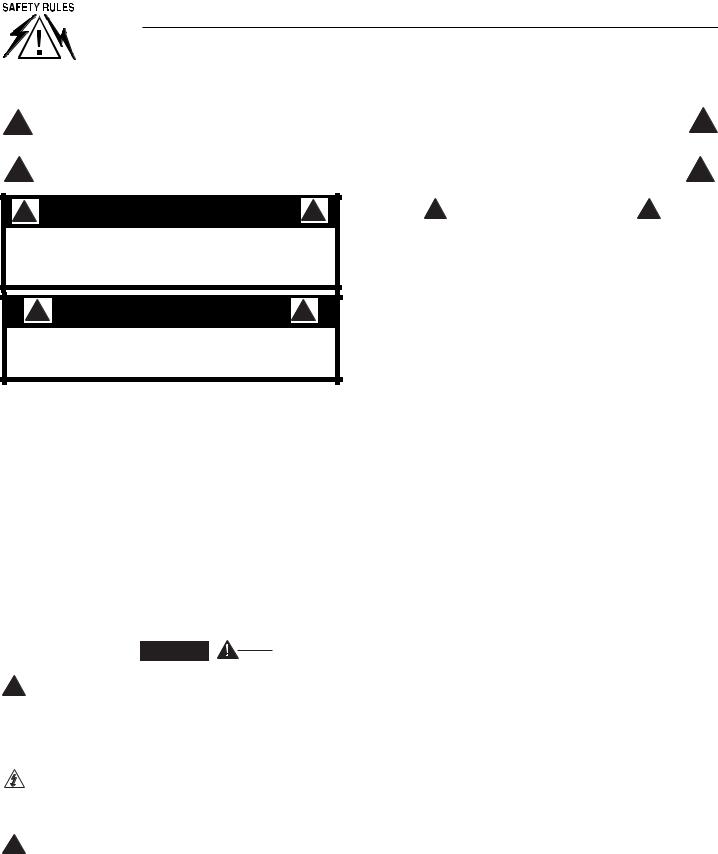
IMPORTANT SAFETY INSTRUCTIONS
Guardian 40kW Liquid-cooled Generators
SAVE THESE INSTRUCTIONS – The manufacturer suggests that these rules for safe
!operation be copied and posted in potential hazard areas. Safety should be stressed to all operators, potential operators, and service and repair technicians for this equipment.
SAVE THESE INSTRUCTIONS – This manual contains important instructions that should be
!followed during installation and maintenance of the generator and batteries.
!
!
! WARNING: !
The engine exhaust from this product contains chemicals known to the state
of California to cause cancer, birth defects or other reproductive harm.
! |
WARNING: |
! |
|
|
|
|
This product contains or emits chemicals |
|
|
known to the state of California to cause |
|
cancer, birth defects or other reproductive harm. |
||
Study these SAFETY RULES carefully before installing, operating or servicing this equipment. Become familiar with this Owner’s Manual and with the unit. The generator can operate safely, efficiently and reliably only if it is properly installed, operated and maintained. Many accidents are caused by failing to follow simple and fundamental rules or precautions.
Generac cannot anticipate every possible circumstance that might involve a hazard. The warnings in this manual, and on tags and decals affixed to the unit are, therefore, not all-inclusive. If using a procedure, work method or operating technique that Generac does not specifically recommend, ensure that it is safe for others. Also make sure the procedure, work method or operating technique chosen does not render the generator unsafe.

 DANGER
DANGER
Despite the safe design of this generator,
!operating this equipment imprudently, neglecting its maintenance or being careless can cause possible injury or death. Permit only responsible and capable persons to install, operate or maintain this equipment.
Potentially lethal voltages are generated by these machines. Ensure all steps are taken to render the machine safe before attempting to work on the generator.
Parts of the generator are rotating and/or hot
!during operation. Exercise care near running generators.
! GENERAL HAZARDS !
•For safety reasons, Generac recommends that this equipment be installed, serviced and repaired by an authorized service dealer or other competent, qualified electrician or installation technician who is familiar with applicable codes, standards and regulations. The operator also must comply with all such codes, standards and regulations.
•Installation, operation, servicing and repair of this (and related) equipment must always comply with applicable codes, standards, laws and regulations. Adhere strictly to local, state and national electrical and building codes. Comply with regulations the Occupational Safety and Health Administration (OSHA) has established. Also, ensure that the generator is installed, operated and serviced in accordance with the manufacturer’s instructions and recommendations. Following installation, do nothing that might render the unit unsafe or in noncompliance with the aforementioned codes, standards, laws and regulations.
•The engine exhaust fumes contain carbon monoxide gas, which can be DEADLY. This dangerous gas, if breathed in sufficient concentrations, can cause unconsciousness or even death. For that reason, adequate ventilation must be provided. Exhaust gases must be piped safely away from any building or enclosure that houses the generator to an area where people, animals, etc., will not be harmed. This exhaust system must be installed properly, in strict compliance with applicable codes and standards.
•Keep hands, feet, clothing, etc., away from drive belts, fans, and other moving or hot parts. Never remove any drive belt or fan guard while the unit is operating.
•Adequate, unobstructed flow of cooling and ventilating air is critical to prevent buildup of explosive gases and to ensure correct generator operation. Do not alter the installation or permit even partial blockage of ventilation provisions, as this can seriously affect safe operation of the generator.
•Keep the area around the generator clean and uncluttered. Remove any materials that could become hazardous.
•When working on this equipment, remain alert at all times. Never work on the equipment when physically or mentally fatigued.
2 Generac® Power Systems, Inc.

IMPORTANT SAFETY INSTRUCTIONS
Guardian 40kW Liquid-cooled Generators
•Inspect the generator regularly, and promptly repair or replace all worn, damaged or defective parts using only factory-approved parts.
•Before performing any maintenance on the generator, disconnect its battery cables to prevent accidental start-up. Disconnect the cable from the battery post indicated by a NEGATIVE, NEG or (–) first. Reconnect that cable last.
•Never use the generator or any of its parts as a step. Stepping on the unit can stress and break parts, and may result in dangerous operating conditions from leaking exhaust gases, fuel leakage, oil leakage, etc.
 ELECTRICAL HAZARDS
ELECTRICAL HAZARDS 
•All generators covered by this manual produce dangerous electrical voltages and can cause fatal electrical shock. Utility power delivers extremely high and dangerous voltages to the transfer switch as well as the standby generator. Avoid contact with bare wires, terminals, connections, etc., on the generator as well as the transfer switch, if applicable. Ensure all appropriate covers, guards and barriers are in place before operating the generator. If work must be done around an operating unit, stand on an insulated, dry surface to reduce shock hazard.
•Do not handle any kind of electrical device while standing in water, while barefoot, or while hands or feet are wet. DANGEROUS ELECTRICAL SHOCK MAY RESULT.
•If people must stand on metal or concrete while installing, operating, servicing, adjusting or repairing this equipment, place insulative mats over a dry wooden platform. Work on the equipment only while standing on such insulative mats.
•The National Electrical Code (NEC), Article 250 requires the frame and external electrically conductive parts of the generator to be connected to an approved earth ground and/or grounding rods. This grounding will help prevent dangerous electrical shock that might be caused by a ground fault condition in the generator set or by static electricity. Never disconnect the ground wire.
•Wire gauge sizes of electrical wiring, cables and cord sets must be adequate to handle the maximum electrical current (ampacity) to which they will be subjected.
•Before installing or servicing this (and related) equipment, make sure that all power voltage supplies are positively turned off at their source. Failure to do so will result in hazardous and possibly fatal electrical shock.
•Connecting this unit to an electrical system normally supplied by an electric utility shall be by means of a transfer switch so as to isolate the generator electric system from the electric utility distribution system when the generator is operating. Failure to isolate the two electric system power sources from each other by such means will result in damage to the generator and may also result in injury or death to utility power workers due to backfeed of electrical energy.
•Generators installed with an automatic transfer switch will crank and start automatically when NORMAL (UTILITY) source voltage is removed or is below an acceptable preset level. To prevent such automatic start-up and possible injury to personnel, disable the generator’s automatic start circuit (battery cables, etc.) before working on or around the unit. Then, place a “Do Not Operate” tag on the generator control panel and on the transfer switch.
•In case of accident caused by electric shock, immediately shut down the source of electrical power. If this is not possible, attempt to free the victim from the live conductor. AVOID DIRECT CONTACT WITH THE VICTIM. Use a nonconducting implement, such as a dry rope or board, to free the victim from the live conductor. If the victim is unconscious, apply first aid and get immediate medical help.
•Never wear jewelry when working on this equipment. Jewelry can conduct electricity resulting in electric shock, or may get caught in moving components causing injury.
 FIRE HAZARDS
FIRE HAZARDS 
•Keep a fire extinguisher near the generator at all times. Do NOT use any carbon tetra-chloride type extinguisher. Its fumes are toxic, and the liquid can deteriorate wiring insulation. Keep the extinguisher properly charged and be familiar with its use. If there are any questions pertaining to fire extinguishers, consult the local fire department.
 EXPLOSION HAZARDS
EXPLOSION HAZARDS 
•Properly ventilate any room or building housing the generator to prevent build-up of explosive gas.
•Do not smoke around the generator. Wipe up any fuel or oil spills immediately. Ensure that no combustible materials are left in the generator compartment, or on or near the generator, as FIRE or EXPLOSION may result. Keep the area surrounding the generator clean and free from debris.
•Generac generator sets may operate using one of several types of fuels. All fuel types are potentially FLAMMABLE and/or EXPLOSIVE and should be handled with care. Comply with all laws regulating the storage and handling of fuels. Inspect the unit’s fuel system frequently and correct any leaks immediately. Fuel supply lines must be properly installed, purged and leak tested according to applicable fuel-gas codes before placing this equipment into service.
•Diesel fuels are highly FLAMMABLE. Gaseous fluids such as natural gas and liquid propane (LP) gas are extremely EXPLOSIVE. Natural gas is lighter than air, and LP gas is heavier than air; install leak detectors accordingly.
Generac® Power Systems, Inc. 3
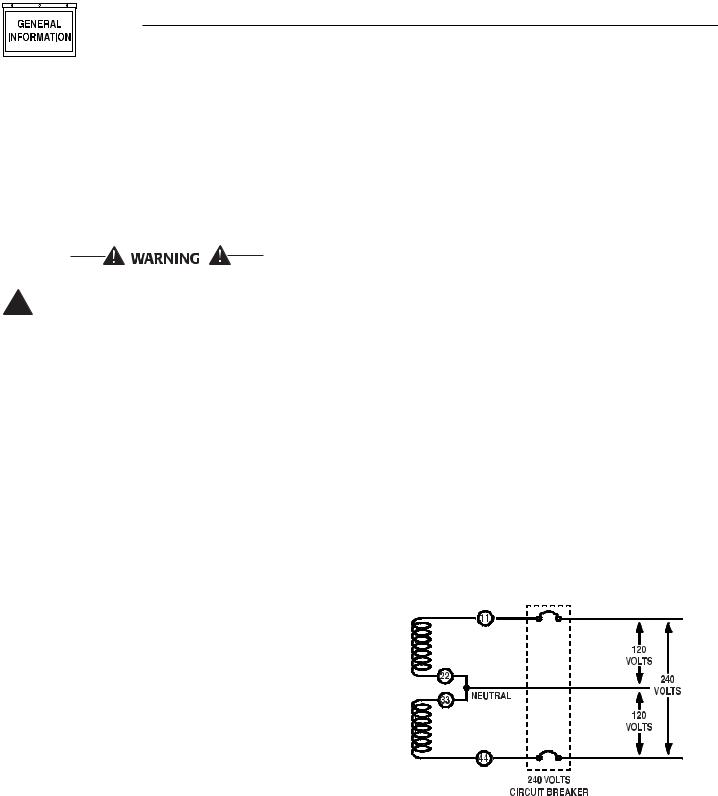
Section 1 - General Information
Guardian 40kW Liquid-cooled Generators
1.1GENERATOR
This equipment is a liquid-cooled, engine-driven generator set. The generator is designed to supply electrical power that operates critical electrical loads during utility power failure. The unit has been facto- ry-installed in a weather resistant, all metal enclosure and is intended for outdoor installation only. Use this generator as a source of electrical power for the operation of 120 and/or 240VAC, single-phase loads.
If this generator is used to power electrical
!load circuits normally powered by a utility power source, it is required by code to install a transfer switch. The transfer switch must effectively isolate the electric system from the utility distribution system when the generator is operating (NEC 701). Failure to isolate an electrical system by such means results in damage to the generator and may also result in injury or even death to utility power workers due to backfeed of electrical energy.
1.2TRANSFER SWITCH
This generator system includes a matched 200 amp automatic transfer switch which is intended to be used in conjunction with the generator. It is supplied in a NEMA 3R enclosure. The NEMA 3R enclosure is weather resistant and can be used indoors or outdoors. Follow these rules:
•Install the transfer switch on a firm, sturdy supporting structure.
•To prevent switch distortion, level the switch if necessary. This can be done by placing washers between the switch enclosure and the mounting surface.
•Never install the switch where water or any corrosive substance might drip onto the enclosure.
•Protect the switch at all times against excessive moisture, dust, dirt, lint, construction grit and corrosive vapors.
1.3AUTOMATIC SYSTEM OPERATION
When this generator, along with a transfer switch, has been installed and interconnected, a circuit board in the generator panel constantly monitors UTILITY power source voltage. Should that voltage drop below a preset value, and remain at such a low state for a preset amount of time, the generator cranks and starts. After the generator starts, the transfer switch transfers load circuits so the generator can power them.
When utility source voltage has been restored, the switch re-transfers back to the UTILITY source voltage and the generator then shuts down.
Please reference the transfer switch manual for specific information.
1.4GENERATOR AC CONNECTION
SYSTEMS
The generator was shipped from the factory with its stator AC output leads connected in a single-phase, three-wire generator AC connection system (Figure 1.1). The stator assembly in this system consists of a pair of stationary windings, with two leads brought out of each winding. Each single winding can supply 120VAC, 60 Hertz. When the two windings are connected in series, a 240VAC, 60 Hertz AC output results. Typically the two HOT leads in the circuit are wires 11 and 44. The NEUTRAL leads are the junction of Wires 22 and 33. The NEUTRAL is not grounded.
Figure 1.1 - Generator AC Connection System
|
|
|
1.5 |
MAIN CIRCUIT BREAKER |
|
|
|
|
The generator’s main circuit breaker is included with |
||
|
|
|
the unit as shipped from the factory. The breaker for |
||
|
|
|
this unit is described in Figure 1.2. |
||
|
|
Figure 1.2 - Main Circuit Breaker |
|
||
Model |
Rating |
Phase |
Actual Current |
C/B Rating* |
Circuit Breaker |
004992-0 |
37,000 NG |
1 |
154.2 |
200 |
200A QN2 |
|
40,000 LP |
1 |
166.7 |
200 |
200A QN2 |
* Amp Rating of C/B structured under model.
4 Generac® Power Systems, Inc.
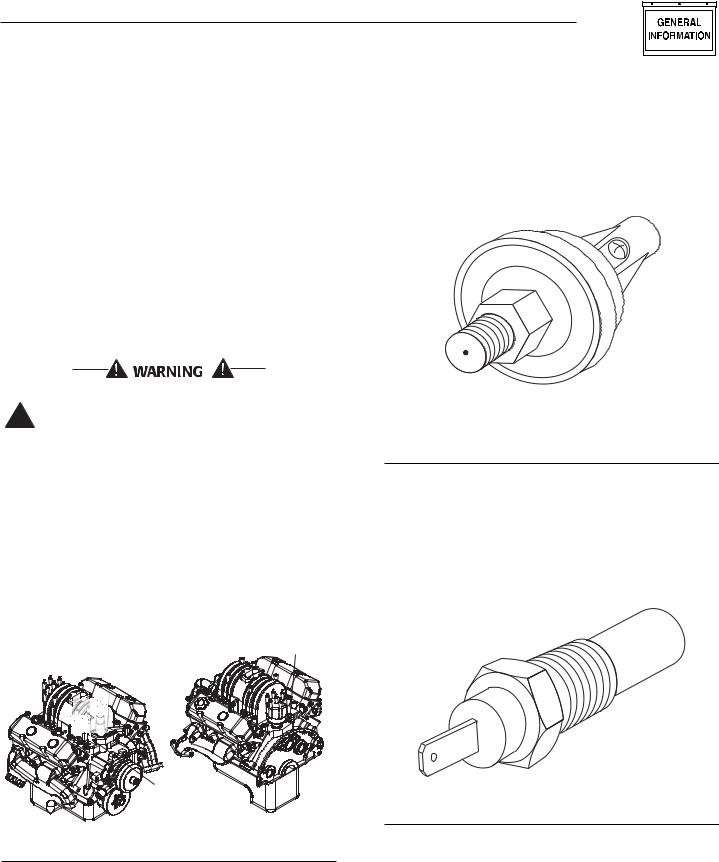
Section 1 - General Information
Guardian 40kW Liquid-cooled Generators
1.6 GENERATOR FUEL SYSTEM |
NOTE: |
The unit has been factory tested and adjusted using a natural gas fuel system. If propane (LP) gas is necessary, refer to Section 1.12 for conversion.
Fuel pressure for a natural gas set up should be five inches to 14 inches of water column (0.18 to 0.5 psi) at all load ranges.
Fuel pressure for an LP vapor set up should be 11 inches to 14 inches of water column (0.4 to 0.5 psi) at all load ranges.
NOTE:
A seperate gas line and regulator may be needed to assure proper gas pressure to the generator. Improper gas pressure can cause hard starting and affect engine durability.
Gaseous fuels such as natural and LP
!(propane) gas are highly explosive. Even the slightest spark can ignite such fuels and cause an explosion. No leakage of fuel is permitted. Natural gas, which is lighter than air, tends to collect in high areas. LP gas is heavier than air and tends to settle in low areas.
1.7ENGINE PROTECTIVE DEVICES
The engine has several safety switches which cause the engine to automatically shut down under the following conditions: low oil pressure, high coolant temperature, engine overspeed, low coolant level or overcrank (Figure 1.3).
Figure 1.3 - Engine Protective Devices
Low Oil Pressure Switch
High Coolant
Temperature Switch
Low Coolant
Level Sensor
1.7.1 LOW OIL PRESSURE SWITCH
This switch is normally-closed (N.C.) but is held open by engine oil pressure during engine running. Should operating oil pressure drop below about 8-10 psi (55-68 kPa), the switch contacts close, the engine shuts down automatically, and the low oil pressure LED is turned ON (Figure 1.4).
The Low Oil Pressure, High Coolant Temperature and Low Coolant Level are not monitored for the first 10 seconds of engine run time.
Figure 1.4 - Low Oil Pressure Switch
1.7.2 HIGH COOLANT TEMPERATURE SWITCH
Normally open (N.O.) thermostatic switch has sensing tip which is immersed in captive coolant. Should coolant temperature exceed about 230°F (110°C), the switch contacts close. This causes the engine to shut down automatically and turns on the high coolant temperature/low coolant level LED (Figure 1.5).
Figure 1.5- High Coolant Temperature Switch
1.7.3 LOW COOLANT LEVEL SWITCH
Should engine coolant level drop below the level of the high coolant temperature switch, it is possible for the engine to overheat without automatic shutdown. To prevent such overheating without automatic shut down, the engine has a low coolant level sensor. If the engine coolant drops too low, the engine automatically shuts down and turns on the high coolant temperature/low coolant level LED (Figure 1.6 on page 6).
Generac® Power Systems, Inc. 5
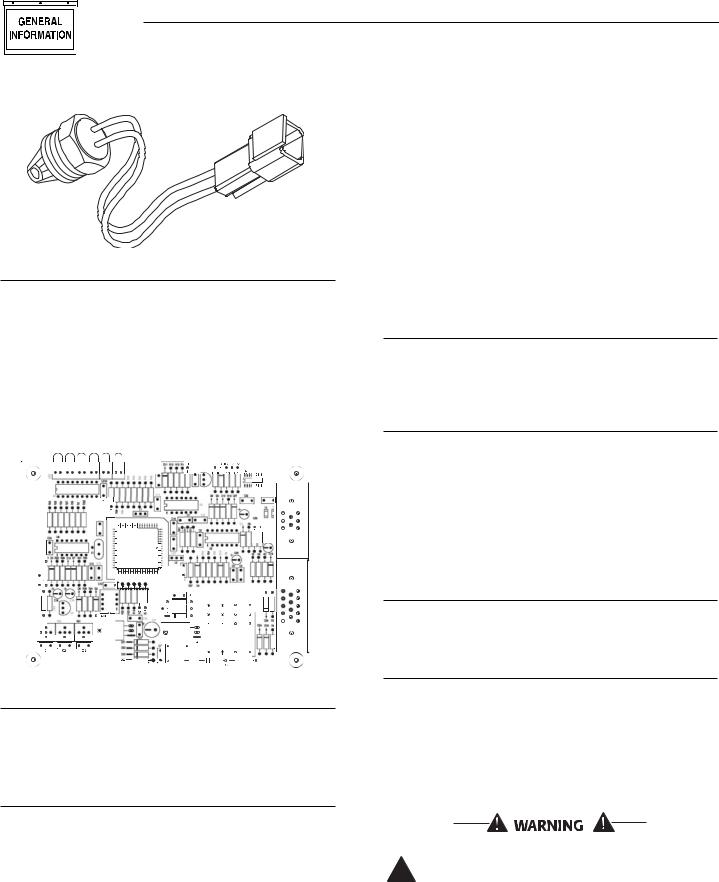
Section 1 — General Information
Guardian 40kW Liquid-cooled Generators
Figure 1.6 - Low Coolant Level Sensor |
1.7.7 LOW BATTERY |
1.7.4 OVERSPEED SHUTDOWN
The engine control board receives AC frequency signals from an engine run winding in the alternator. Should AC frequency exceed about 72 Hertz for three seconds or 75 Hertz instantaneously, the engine shuts down and the overspeed LED turns on. Should AC frequency exceed about 72 Hertz, circuit board action will automatically shutdown the engine (Figure 1.7).
Figure 1.7 - Printed Circuit Board Assembly
R44
LED1
C9 |
C27 |
Q2 |
2
J2
C26
U7
C4
 D10
D10
|
|
C21 |
C30 |
|
|
|
C2 |
|
|
RL1 |
RL2 |
|
R1 |
|
R25 |
R48 |
|
|
D17 |
|
R49 |
|
|
|
U1 |
|
|
|
J1 |
|
L3 |
|
|
PCB#0E4906.REV |
D19 |
|
|
1.7.5 RPM SENSOR LOSS
If the engine control board does not receive a proper rpm signal from the starter during cranking or running, it shuts down the engine on rpm sensor loss and flash the overspeed LED.
The engine control board continually monitors the battery voltage and turns on the low battery LED if the battery voltage falls below 11.0 VDC for one minute. Low battery voltage is a non-latching alarm, which will automatically clear if the battery voltage rises above 11.0 VDC.
The control system will not attempt to start the engine if there is a low battery condition, however, if the engine is already running when the low battery condition occurs, the engine will continue to run as long as possible.
Battery voltage is NOT monitored during the crank cycle.
1.7.8 ALARM RESET
If the engine control board shuts down the generator for any of the above reasons, the engine remains stopped until the alarm is cleared by placing the AUTO/OFF/MANUAL switch into the OFF position.
1.7.9 DC FUSE
These fuses are located on the front panel of the control system. They protect the panel wiring and components from damaging overload. Always remove the 15 amp main fuse before working on the generator. The unit will not start or crank if this fuse is blown. Replace the fuse with one of the same size, type, and rating (main AGC-15, battery charger AG4).
1.8UNPACKING
1.8.1 UNPACKING PRECAUTIONS
Handle shipping cartons and crates with care. Use care to avoid damage from dropping, bumping, collision, etc..
1.8.2 INSPECTION
After unpacking, carefully inspect the generator for any damage that may have occurred during shipment. If loss or damage is noted at the time of delivery, have the person(s) making delivery note all damage on the freight bill or affix his signature under the consignor’s memo of loss or damage.
1.7.6 OVERCRANK SHUTDOWN
The engine control board uses a cyclic cranking process when attempting to start the engine. The first crank cycle is a 15-second crank followed by a sevensecond rest. This is followed by five more crank cycles each with a seven second crank followed by a seven-second rest.
If the engine fails to start after all six attempts, the start attempt is stopped and the overcrank LED turned on.
1.9LIFTING THE GENERATOR
When lifting or hoisting equipment is used,
!be careful not to touch overhead power lines. The generators weight of more than 1400 pounds requires proper tools, equipment, and qualified personnel to be used in all phases of handling and unpacking.
6 Generac® Power Systems, Inc.
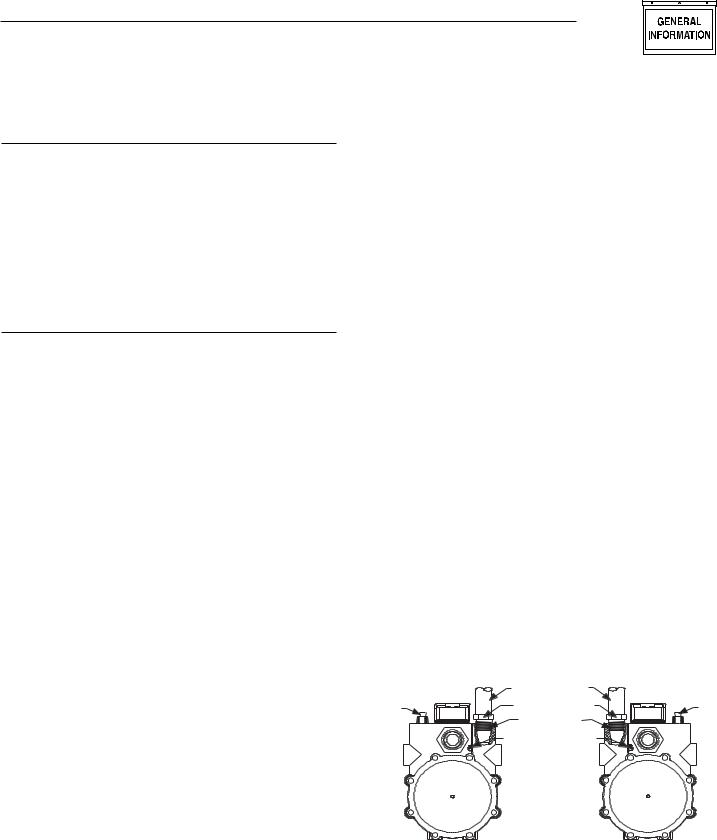
Section 1 — General Information
1.10 SPECIFICATIONS
1.10.1 GENERATOR SPECIFICATIONS
Guardian 40kW Liquid-cooled Generators
Fuel pressure for a natural gas set up should be five inches to 14 inches of water column (0.18 to 0.5 psi) at all load ranges.
|
|
Single-phase |
|
|
|
|
|
|
Model |
4992-0 |
|
|
Rated Max. Cont. |
37 (NG), 40 (LP) |
|
|
AC Power Output (kW) |
|
|
|
Rated voltage (volts) |
120/240 |
|
|
No. of Rotor Poles |
4 |
|
|
Driven Speed of Rotor |
1800 |
|
|
Rotor Excitation System |
Direct excited brush type |
|
|
Type of Stator |
4 Wire |
|
|
Rotor/Stator Insulation |
Class F/H |
|
|
|
|
|
|
|
|
|
1.10.2 ENGINE SPECIFICATIONS
Make.................................................................................................. |
Chrysler |
Displacement .................................................................................... |
3.9 liters |
Cylinder Arrangement .............................................................................. |
V-6 |
Valve Arrangement ................................................................ |
Overhead Valve |
Firing Order .................................................................................. |
1-6-5-4-3-2 |
Number of Main Bearings ............................................................................ |
4 |
Compression Ratio ............................................................................ |
9.1 to 1 |
No. of Teeth on Flywheel .......................................................................... |
164 |
Ignition Timing at 1800 rpm .............................................. |
30 degrees BTDC |
Spark Plug Gap................................................................ |
1.01mm (0.040 in.) |
Recommended Spark Plugs |
|
Champion...................................................................................... |
RC12LC4 |
Oil Pressure .................................................................................... |
30-80 psi |
Crankcase Oil Capacity ........................................ |
4.0 U.S. quarts (3.8 liters) |
Recommended Engine Oil ........................................................ |
SAE 15W-40 |
Type of Cooling System .................................. |
Pressurized, closed recovery |
Cooling Fan ................................................................................ |
Pusher Type |
Cooling System Capacity .................................. |
5.0 U.S. gallons (19.3 liters) |
Recommended Coolant ............................................ |
Use a 50-50 mixture of |
|
ethylene glycol base |
|
and de-ionized water. |
1.11 FUEL CONSUMPTION
Natural Gas:
% of Load |
25% |
50% |
75% |
100% |
m3/hr |
4.1 |
7.7 |
11.0 |
14.2 |
ft3/hr |
143.1 |
271.1 |
388.5 |
502.0 |
LP Vapor:
Fuel pressure for an LP vapor set up should be 11 inches to 14 inches of water column (0.4 to 0.5 psi) at all load ranges.
1.12 RECONFIGURING THE FUEL SYSTEM
Fuel pressure for both natural gas and liquid propane set ups should be 11 inches to 14 inches of water column (0.4 to 0.5 psi) at all load ranges.
NOTE:
All models are configured for natural gas from the factory.
To reconfigure the fuel system from NG to LP vapor, follow these steps:
1.Turn the main gas supply off.
2.Remove the carburetor fuel hose from the outlet port (Port 1) of the demand regulator (Figure 1.8).
3.Remove the brass hose fitting from the outlet port (Port 1) of the demand regulator.
4.Remove pipe plug from Port 2.
5.Install brass hose fitting into Port 2.
6.Install pipe plug into Port 1.
7.Connect carburetor gas hose to brass fitting.
8.Tighten all clamps and plugs.
9.Make sure fuel supply is of the proper pressure and type for configuration.
10.Reverse the procedure to convert back to natural gas.
Figure 1.8 — Reconfigure the Fuel System
|
Port 1 |
|
Port 2 |
|
|
FUEL HOSE |
FUEL HOSE |
|
|
PLUG |
BRASS HOSE |
BRASS HOSE |
PLUG |
|
FITTING |
FITTING |
|||
|
||||
|
OUT |
OUT |
|
|
|
PORT 1 |
PORT 2 |
|
|
|
HOUSING |
HOUSING |
|
|
|
PORTS |
|
||
|
PORTS |
|
||
|
|
|
% of Load |
25% |
50% |
75% |
100% |
m3/hr |
1.7 |
3.3 |
4.7 |
6.0 |
ft3/hr |
60.7 |
115.0 |
164.9 |
213.0 |
NOTE:
Fuel consumption is given at rated maximum continuous power output when using natural gas rated at 1000 Btu per cubic foot. LP gas is rated at 2520 Btu per cubic foot. Actual fuel consumption obtained may vary depending on such variables as applied load, ambient temperature, engine conditions and other environmental factors.
NG FUEL SYSTEM |
LP FUEL SYSTEM |
NOTE:
Port 1 is for NG only and Port 2 is for LP vapor only. No provision for dual fuel has been made.
Generac® Power Systems, Inc. 7

Section 2 — Installation
Guardian 40kW Liquid-cooled Generators

 DANGER
DANGER
Serious injury or damage may occur if not
!configured properly. Please consult an authorized service dealer with any questions.
1.13 TORQUE SPECIFICATIONS
Tighten the bolts from the middle out, in a crisscross pattern.
Cylinder Head .................................... |
50 ft.lb./105 ft.lb./105 ft.lb. |
Intake Manifold .................................... |
48 in.lb./84 in.lb./84 in.lb. |
Exhaust Manifold.............................................................. |
25 ft.lb. |
Do not use any chromate base rust inhibitor
!with ethylene glycol base anti-freeze or chromiumhydroxide (“green slime”) forms and will cause overheating. Engines that have been operated with a chromate base rust inhibitor must be chemically cleaned before adding ethylene glycol base anti-freeze. Using any high silicate anti-freeze boosters or additives will also cause overheating. It is also recommend that any soluble oil inhibitor is NOT USED for this equipment.
1.14 ENGINE OIL RECOMMENDATIONS
The unit has been filled with 5W-20 engine oil at the factory. Use a high-quality detergent oil classified “For Service CC, SD, SE, SF.” Detergent oils keep the engine cleaner and reduce carbon deposits. Use oil having the following SAE viscosity rating, based on the ambient temperature range anticipated before the next oil change:
|
Temperature |
Oil Grade (Recommended) |
|
|
Above 80° F (27° C) |
SAE 15W-40 |
|
|
32° to 80° F (-1° to 27° C) |
SAE 15W-40 |
|
|
Below 32° F (0° C) |
SAE 15W-40 |
|
NOTE:
Synthetic oil is highly recommended in any element with temperatures above 90° F or below 30° F.
Any attempt to crank or start the engine
!before it has been properly serviced with the recommended oil may result in an engine failure.
1.15 COOLANT RECOMMENDATIONS
Use a mixture of half low silicate ethylene glycol base anti-freeze and half de-ionized water. Cooling system capacity is about 20 U.S. quarts (19.3 liters). Use only de-ionized water and only low silicate antifreeze. If desired, add a high quality rust inhibitor to the recommended coolant mixture. When adding coolant, always add the recommended 50-50 mixture.
1.16 BEFORE INSTALLATION
Before installing this equipment, check the ratings of both the generator and the transfer switch. Read “Emergency Isolation Method” and “Total Circuit Isolation Method” in Sections 2.5 and 2.6.
The generator’s rated wattage/amperage capacity must be adequate to handle all electrical loads that the unit will power. The critical (essential) loads may need to be grouped together and wired into a separate “emergency” distribution panel.
The standard transfer switch has no sensing or controlling circuit boards. Instead, the generator control console houses a “Printed Circuit Board Assembly”, which controls all phases of operation, including engine start up and load transfer.
2.1STANDBY GENERATOR INSTALLATION

 DANGER
DANGER
Connecting this generator to an electrical system normally supplied by an electric utility shall be by means of a transfer switch, so as to isolate the electric system from the utility distribution system when the generator is operating. Failure to isolate the electric system by these means will result in damage to the generator and may also result in injury or death to utility workers due to backfeed of electrical energy.
If an open bottom is used, the engine-genera- tor is to be installed over non-combustible
materials and should be located such that combustible materials are not capable of accumulating under the generator set.
Only qualified, competent installation contractors or electricians thoroughly familiar with applicable codes, standards and regulations should install this standby electric power system. The installation must comply strictly with all codes, standards and regulations pertaining to the installation.
8 Generac® Power Systems, Inc.
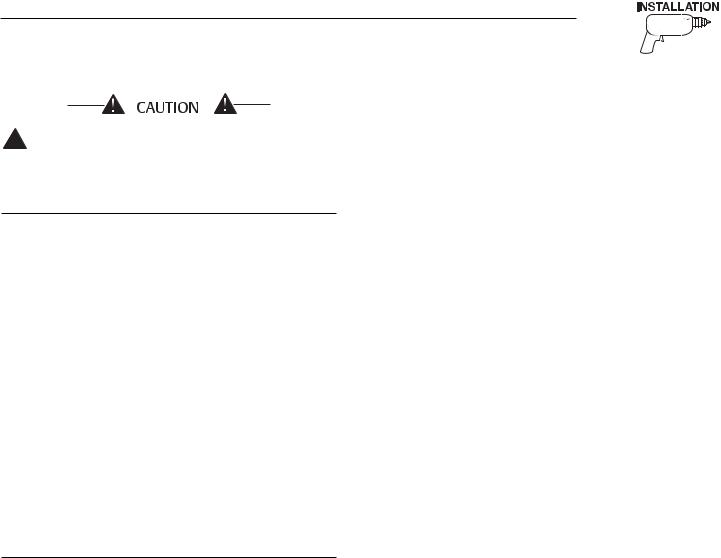
Section 2 — Installation
After the system has been installed, do nothing
!that might render the installation in noncompliance with such codes, standards and regulations.
2.1.1 NFPA STANDARDS
The following published standards booklets pertaining to standby electric systems are available form the National Fire Protection Association (NFPA), Batterymarch Park, Quincy, MA 02269:
NOTE:
It is essential to use the latest version of any standard to ensure correct and current information.
•NFPA No. 37, STATIONARY COMBUSTION ENGINES AND GAS TURBINES.
•NFPA No. 76A, ESSENTIAL ELECTRICAL SYSTEMS FOR HEALTH CARE FACILITIES.
•NFPA No. 220, STANDARD TYPES OF BUILDING CONSTRUCTION
•NFPA No. 68, GUIDE FOR EXPLOSION VENTING
•NFPA No. 70, NATIONAL ELECTRICAL CODE.
•NFPA No. 30, FLAMMABLE AND COMBUSTIBLE LIQUIDS CODE.
•NFPA No. 10, INSTALLATION, MAINTENANCE AND USE OF PORTABLE FIRE EXTINGUISHERS.
2.1.2 OTHER PUBLISHED STANDARDS
In addition to NFPA standards, the following information pertaining to the installation and use of standby electric systems is available:
NOTE:
It is essential to use the latest version of any standard to ensure correct and current information.
Guardian 40kW Liquid-cooled Generators
2.2GENERATOR LOCATION
Install the generator set, in its protective enclosure outdoors, where adequate cooling and ventilating air always is available. Consider these factors:
•Install the unit where air inlet and outlet openings will not become obstructed by leaves, grass, snow, etc. If prevailing winds will cause blowing or drifting, consider using a windbreak to protect the unit.
•Install the generator on high ground where water levels will not rise and endanger it.
•This genset must be installed on a level surface. The base frame must be level within 1/2 inch all around.
•Allow sufficient room on all sides of the generator for maintenance and servicing. A good rule is to allow five feet of space on all sides.
•Where strong prevailing winds blow from one direction, face the generator air inlet openings into the prevailing winds.
•Install the generator as close as possible to the transfer switch. This reduces the length of wiring and conduit.
•Install the generator as close as possible to the fuel supply, to reduce the length of piping. HOWEVER, REMEMBER THAT LAWS OR CODES MAY REGULATE THE DISTANCE.
2.3GENERATOR MOUNTING AND
SUPPORT
Retain the generator compartment to a concrete slab with 1/4-inch masonry type anchor bolts. Be sure the bolts are long enough to retain the compartment. The slab should be at least six inches thick and should extend beyond the enclosure to a distance of at least three inches on all sides. See Section 6 for generator major dimensions.
•Article X, NATIONAL BUILDING CODE, available from the American Insurance Association, 85 John Street, New York, N.Y. 10038.
•AGRICULTURAL WIRING HANDBOOK, obtainable from the Food and Energy Council, 909 University Avenue, Columbia, MO, 65201.
•ASAE EP-364.2, INSTALLATION AND MAINTENANCE OF FARM STANDBY ELECTRIC POWER, available from the American Society of Agricultural Engineers, 2950 Niles Road, St. Joseph, MI 49085.
•A52.1, AMERICAN NATIONAL STANDARD FOR CHIMNEYS, FIREPLACES AND VENTING SYSTEMS, available from the American National Standard Institute, 1430 Broadway, New York, N.Y. 10018.
2.4BASIC STANDBY ELECTRIC
SYSTEM
Figure 2.1 (on page 10) shows a schematic diagram of a basic standby electric system. Both the UTILITY power supply and the STANDBY (GENERATOR) output are connected to an approved transfer switch. The transfer switch is required by electrical code and serves the following functions:
•Allows the LOAD circuits to be connected to only one power supply at a time.
•Prevents electrical backfeed between the generator and the UTILITY power circuits.
Notice that both the STANDBY and the UTILITY power supplies to the transfer switch are protected against overload by a main line circuit breaker.
Generac® Power Systems, Inc. 9
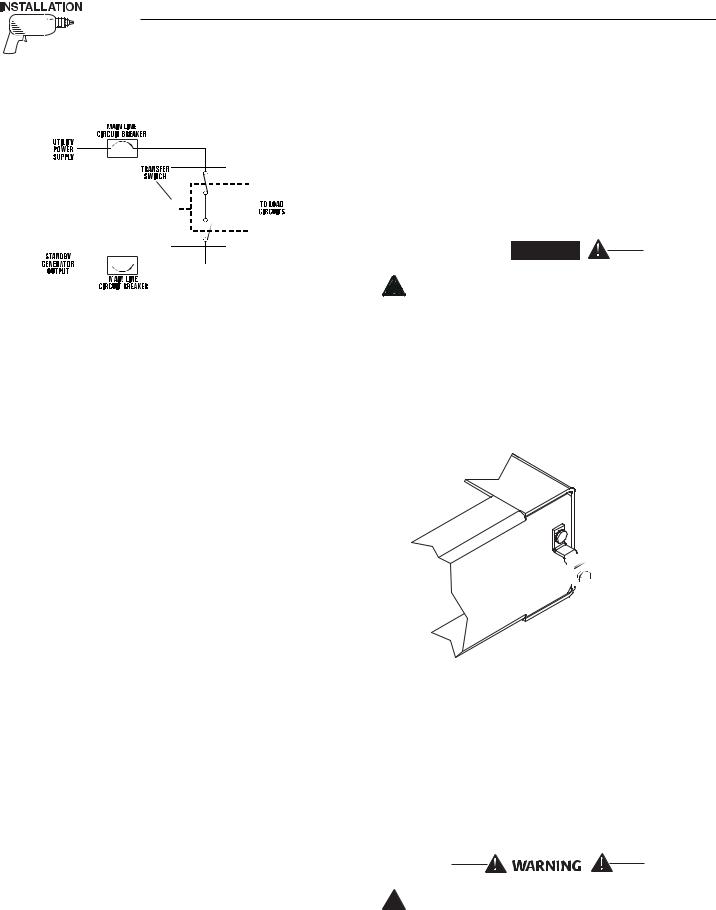
Section 2 — Installation
Guardian 40kW Liquid-cooled Generators
Figure 2.1 – Basic Standby Electric System |
2.7 GROUNDING THE GENERATOR |
2.5EMERGENCY CIRCUIT ISOLATION
METHOD
This prevents overloading the generator by keeping electrical loads below the wattage/amperage capacity of the generator. If the generator is powering only critical loads, within the wattage/amperage capacity, during utility power outages, consider using the emergency circuit isolation method.
Critical electrical loads are grouped together and wired into a separate “Emergency Distribution Panel.” Load circuits powered by that panel are within the wattage/amperage capacity of the generator set. When this method is used, it is difficult to overload the generator. The transfer switch must meet the following requirements:
•It must have an ampere rating equal to the total amperage rating of the emergency distribution panel circuit.
•Have it installed between the building’s main distribution panel and the emergency distribution panel.
2.6TOTAL CIRCUIT ISOLATION
METHOD
When a generator capable of powering all electrical loads in the circuit is to be installed, use the “Total Circuit Isolation Method.” It is possible for the generator to be overloaded when this isolation method is employed. The following apply to the transfer switch in this type of system.
•Ampere rating of the transfer switch must equal the ampere rating of the normal incoming utility service.
•The transfer switch is installed between the utility service entrance and the building distribution panel.
•In accordance wtih electrical code, an approved means of service disconnect must be installed between the normal incoming utiltiy service entrance and the transfer switch.
The National Electrical Code requires the frame and external electrically conductive parts of this equipment to be properly connected to an approved earth ground and/or grounding rods. For that purpose, a GROUND LUG (Figure 2.2) is provided on the generator mounting base. Consult a qualified electrician for grounding requirements in the area. Grounding procedures must meet local regulations.

 DANGER
DANGER
Do not connect the ground wire to any pipe
that carries a flammable or explosive substance
– FIRE or an EXPLOSION may result.
Proper grounding helps protect personnel against electrical shock in the event of a ground fault condition in the generator or in connected electrical devices. In addition, grounding helps dissipate static electricity that often builds up in ungrounded devices.
Figure 2.2 – Generator Grounding Lug (typical)
 GROUNDING
GROUNDING
 LUG
LUG
2.8GENERATOR AC NEUTRAL
CONNECTIONS
Generac uses an UNGROUNDED AC neutral. Grounding is recommended only at the main service entrance. If the neutral wire is grounded and one of the phase loads becomes grounded, the excessive current opens the load circuit breaker or collapses the generator field. The actual result depends on the electrical characteristics of the particular installed generator.
Failure to connect the generator neutral prop-
!erly will result in unbalanced line-to-neutral voltages. Resulting high voltages will cause equipment damage.
10 Generac® Power Systems, Inc.
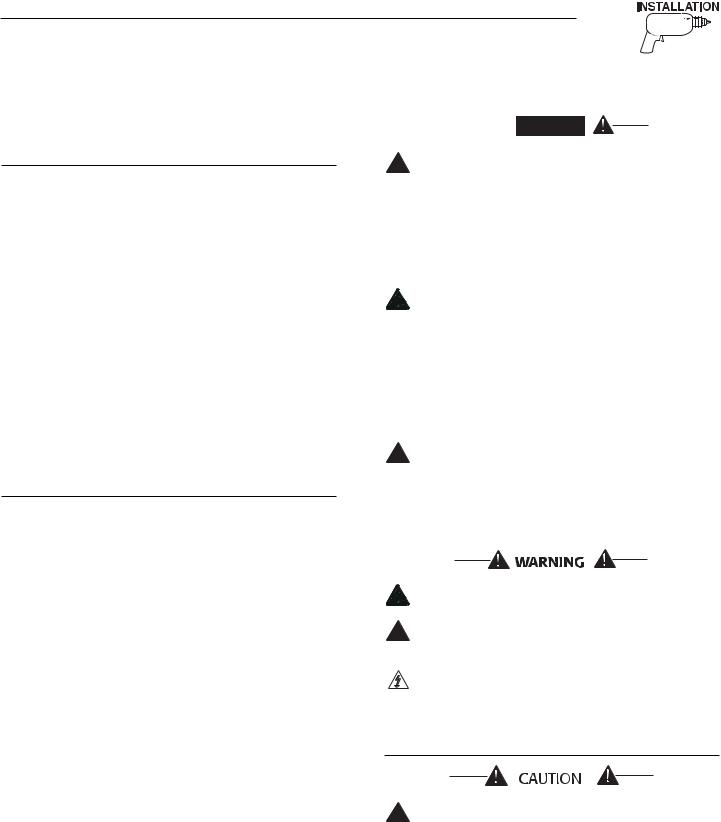
Section 2 — Installation
Guardian 40kW Liquid-cooled Generators
2.9TRANSFER SWITCH SIGNAL CONNECTIONS
2.9.1 PRE-PACKAGED ATS
If the generator is to be installed with a pre-packaged transfer switch, it is necessary to connect the control wires to the generator and set position two of the four-position dip switch to OFF.
Setting switch two to OFF allows the control PCB to perform the ATS control functions.
Control system interconnections consist of N1 and N2, and leads 23 and 194. Control system interconnection leads must be run in a conduit that is separate from the AC power lead. Recommended wire gauge sizes for this wiring depends on the length of the wire, as recommended below:
|
MAXIMUM WIRE LENGTH |
RECOMMENDED WIRE |
|
|
|
SIZE |
|
|
460 feet (140m) |
No. 18 AWG. |
|
|
461 to 730 feet (223m) |
No. 16 AWG. |
|
|
731 to 1,160 feet (354m) |
No. 14 AWG. |
|
|
1,161 to 1,850 feet (565m) |
No. 12 AWG. |
|
|
|
|
|
2.9.2 GTS-TYPE ATS
If the generator is to be installed with an engineered automatic transfer switch, such as a Generac GTStype switch, it is necessary to connect the two-wire start control system.
Connect the two-wire start signal from the automatic transfer switch to the automatic start connection, which is located in the middle, on the bottom, inside the control panel. Match wires 178 and 183 in the transfer switch to 178 and 183 on the terminal strip in the control panel. The conductors for the two-wire start circuit must be in their own conduit. (See Section 3.1 for further explanation.)
NOTE:
It will be necessary to provide a UTILITY supply to the integral battery charger. This battery charger is located in the engine generator control panel. Locate the six position terminal strip in the control panel. Connect a 240 VAC UTILITY supplied source to terminals labeled N1 and N2. The 240 VAC circuit should be protected by a 15A maximum rated circuit breaker.
2.10 BATTERY INSTALLATION

 DANGER
DANGER
Standby generators installed with automatic
! transfer switches will crank and start automatically when NORMAL (UTILITY) source voltage is removed or is below an acceptable preset level. To prevent such automatic start-up and possible injury to personnel, do not connect battery cables until certain that normal source voltage at the transfer switch is correct and the system is ready to be placed into operation.
Storage batteries give off explosive hydrogen gas. This gas can form an explosive mixture around the battery for several hours after charging. The slightest spark can ignite the gas and cause an explosion. Such an explosion can shatter the battery and cause blindness or other injury. Any area that houses a storage battery must be properly ventilated. Do not allow smoking, open flame, sparks or any spark producing tools or equipment near the battery.
Battery electrolyte fluid is an extremely caustic ! sulfuric acid solution that can cause severe
burns. Do not permit fluid to contact eyes, skin, clothing, painted surfaces, etc. Wear protective goggles, protective clothing and gloves when handling a battery. If fluid is spilled, flush the affected area immediately with clear water.
Do not dispose of the battery in a fire. The battery is capable of exploding.
Do not open or mutilate the battery. Released ! electrolyte can be toxic and harmful to the skin
and eyes.
The battery represents a risk of high short circuit current. When working on the battery, always remove watches, rings or other metal objects, and only use tools that have insulated handles.
2.10.1 VENTED BATTERIES
The electrolyte is a dilute sulfuric acid that is
!harmful to the skin and eyes. It is electrically conductive and corrosive. The following procedures are to be observed:
•Wear full eye protection and protective clothing,
•Where electrolyte contacts the skin, wash it off immediately with water,
•Where electrolyte contacts the eyes, flush thoroughly and immediately with water and seek medical attention, and
Generac® Power Systems, Inc. 11

Section 2 — Installation
Guardian 40kW Liquid-cooled Generators
•Spilled electrolyte is to be washed down with an acid-neutralizing agent. A common practice is to use a solution of one pound (500 grams) bicarbonate of soda to one gallon (4 liters) of water. The bicarbonate of soda solution is to be added until the evidence of reaction (foaming) has ceased. The resulting liquid is to be flushed with water and the area dried.
Lead acid batteries present a risk of fire because they generate hydrogen gas. The following procedure are to be followed:
•DO NOT SMOKE when near batteries,
•DO NOT cause flame or spark in battery area, and
•Discharge static electricity from body before touching batteries by first touching a grounded metal surface.
Servicing of batteries is to be performed or supervised by personnel knowledgeable of batteries and the required precautions. Keep unauthorized personnel away from batteries.
The recommended battery is Group 27F, 12V negative ground, 700 CCA/90 AH minimum capacity. All batteries must be at 100 percent state-of-charge before they are installed on the generator.
When using maintenance-free batteries, it is not necessary to check the specific gravity or electrolyte level. Have these procedures performed at the intervals specified in Section 4, “Maintenance.” A negative ground system is used. Battery connections are shown on the wiring diagrams. Make sure all batteries are correctly connected and terminals are tight. Observe battery polarity when connecting batteries to the generator set.
NOTE:
Damage will result if the battery connections are made in reverse.
2.11 PREPARATION BEFORE START-UP
Before starting the generator for the first time, the installer must complete the following procedures. For follow-up maintenance information and/or service intervals, please refer to Section 4, “Maintenance.”
2.11.2 TRANSFER SWITCH
If this generator is used to supply power to any electrical system normally powered by an electric utility, the National Electrical Code requires that a transfer switch be installed. The transfer switch prevents electrical backfeed between two different electrical systems (for additional information, see the applicable transfer switch manual for this unit). The transfer switch, as well as the generator and other standby components, must be properly located and mounted in strict compliance with applicable codes, standards and regulations.
2.11.3 FUEL SYSTEM
Make sure the fuel supply system to the generator (a) delivers the correct fuel at the correct pressure and
(b) is properly purged and leak tested according to code. No fuel leakage is permitted. See “Specifications” (Section 1.10) for more information.
2.11.4 GENERATOR SET LUBRICATION
Check the engine crankcase oil level before operating and add oil to the proper level – the dipstick “FULL” mark. Never operate the engine with the oil level below the dipstick “ADD” mark. See “Specifications” (Section 1.10) and “Engine Oil Recommendations” (Section 1.14).
NOTE:
This engine is shipped from the manufacturer with 5W-20 oil. This oil should be changed after 30 hours of operation.
The instructions in this section assume that the standby generator has been properly installed, serviced, tested, adjusted and otherwise prepared for use by a competent, qualified installation contractor. Be sure to read the “Safety Rules” on pages 2 and 3, as well as all other safety information in this manual, before attempting to operate this (and related) equipment.
2.11.1 PRIOR TO INITIAL START-UP
Prior to initially starting the generator, it must
!be properly prepared for use. Any attempt to crank or start the engine before it has been properly serviced with the recommended types and quantities of engine fluids (oil, coolant, fuel, etc.) may result in an engine failure.
2.11.5 ENGINE COOLANT
Have the engine cooling system properly filled with the recommended coolant mixture. Check the system for leaks and other problems. See “Specifications” (Section 1.10) and “Coolant” (Section 1.15).
2.11.6 BELT TENSION
Check the engine fan belt tension and condition prior to placing the unit into service and at recommended intervals. Belt tension is correct when a force of approximately 22 pounds (10 kg), applied midway between pulleys, deflects the belt about 3/8- to 5/8- inch (10 to 16 mm).
2.11.7 ELECTRICAL SYSTEM
Make sure the generator is properly connected to an approved earth ground and/or ground rod.
12 Generac® Power Systems, Inc.
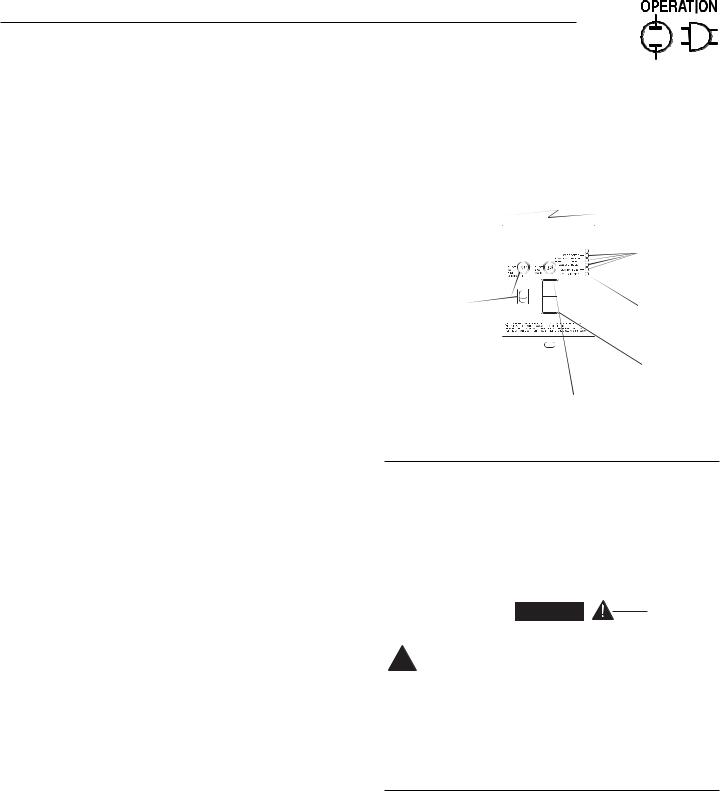
Section 3 - Operation
Make sure the generator battery is fully charged, properly installed and interconnected, and ready for use.
Check to ensure that there are no loose electrical connections. Restrain any loose wires to keep them clear of any moving generator set components.
3.1USING AN ENGINEERED “GTS”
TRANSFER SWITCH
When required, the pre-packaged standby generator can be installed with an engineered Generac “GTS” type automatic transfer switch.
In this application, the GTS is responsible for utility sensing, weekly exercising, and load transferring.
Position two of the four-position dip switch is used to turn over this control to the GTS.
Pos2 ON — GTS Application
Guardian 40kW Liquid-cooled Generators
3.2CONTROL CONSOLE
COMPONENTS
The components of a home standby generator control console (Figure 3.1) are as follows:
Figure 3.1 - Home Standby Generator Panel
SET EXECISER TIME SWITCH
LED INDICATORS:
FLASHING GREEN LED = NO UTILITY SENSE
5 FLASHING RED LED'S = EXERCISER NOT SET
(IN AUTO MODE ONLY) SOLID GREEN LED = SYSTEM READY, UTILITY POWER ON RED LED'S = INDIVIDUAL FAULT
(SEE OWNER'S MANUAL FOR COMPLETE LED DETAILS)
|
|
OVER CRANK |
RED LED |
|
|
|
|
SE |
F |
SE |
|
|
|
AUTO |
|
OFF |
|
|
|
|
|
OFF |
|
ON |
|
|
|
SET |
MANUAL |
GREEN LED |
|
|
|
TO SET EXERCISER TIME |
|
EXERCISE
TIME
1) PLACE AUTO/OFF/MANUAL SWITCH TO AUTO POSITION.
0E7194
•The control board will NOT monitor utility.
•The control board will NOT perform a weekly exercise. (The five red LEDs will not flash in this mode.)
•The control board will NOT activate the transfer output.
•The control board WILL monitor all engine conditions and shut down on all the faults listed in this document.
Pos2 OFF — ATS Application (Included switch)
•The control board will perform all of the automatic features listed in this document.
•The two-wire start connections should NOT be used.
|
AUTO/OFF/MANUAL |
4A FUSE |
SWITCH |
|
|
BATTERY |
15A FUSE |
CHARGER |
MAIN |
|
POWER |
3.2.1 AUTO/OFF/MANUAL SWITCH
Use this three-position switch as follows:
•Set the switch to AUTO for fully automatic operation. See “Automatic Operation” (Section 3.5).
•Set switch to MANUAL position to crank and start the generator engine.
•Set switch to OFF position to shut down an operating engine. With OFF selected, operation will not be possible.
GTS Mode Operation
When in GTS mode, the control board will respond as follows based on the AUTO/OFF/MANUAL switch position.
OFF — The generator will not start and run in this position.
MANUAL — The control board will start and run the generator whenever the switch is in the manual position.
AUTO — The control board will monitor the two-wire start circuit. When a two-wire start is issued the control board will immediately start and run the generator. Whe the two-wire start is removed the control board will immediately stop the generator.
NOTE:
If the generator is installed in conjunction with an engineered GTS type transfer switch, refer to the applicable transfer switch manual for exact operating parameters and timing sequences.

 DANGER
DANGER
With switch set to AUTO, engine can crank
!and start suddenly without warning. Such automatic start up normally occurs when utility source voltage drops below a pre-set level. To prevent possible injury that might be caused by such sudden starts, set AUTO/OFF/ MANUAL switch to OFF before working on or around the unit. Then, place a “DO NOT OPERATE” tag on control console.
3.2.2 FAULT INDICATOR LEDS
These LEDs turn ON when one of the following engine faults occurs and the engine shuts down.
•Low Oil Pressure
•Overcrank
•Low Battery
•Overspeed/RPM Sensor Loss
•High Coolant Temperature/Low Coolant Level
See Section 1.7 for further explanation of engine protection functions.
Generac® Power Systems, Inc. 13
